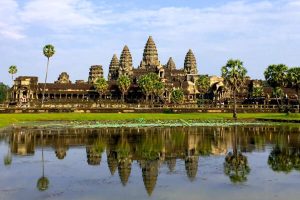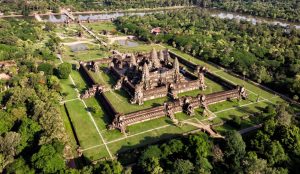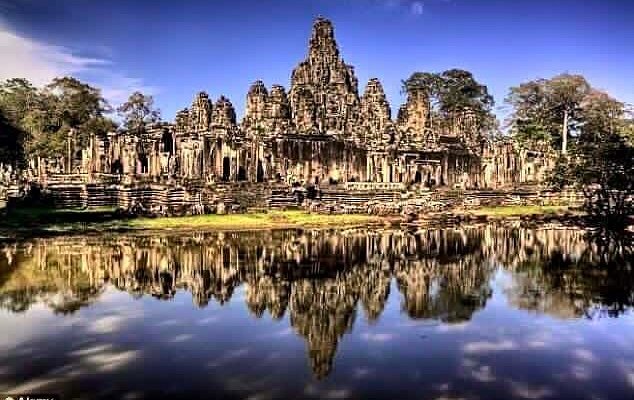Angkor Wat Temple

Angkor Wat is a Hindu-Buddhist temple complex in Cambodia. Located on a site measuring 162.6 hectares (1.6 km2; 401.8 acres) within the ancient Khmer capital city of Angkor, it was originally constructed in 1150 CE as a Hindu temple dedicated to the deity Vishnu. It was later gradually transformed into a Buddhist temple towards the end of the century. Considered by some experts to be the largest religious structure in the world, it is regarded as one of the best examples of Khmer architecture and a symbol of Cambodia, depicted as a part of the Cambodian national flag.
Angkor Wat was built at the behest of the Khmer king Suryavarman II in the early 12th century in Yaśodharapura (present-day Angkor), the capital of the Khmer Empire, as his state temple and eventual mausoleum. Angkor Wat combines two basic plans of Khmer temple architecture: the temple-mountain and the later galleried temple. It is designed to represent Mount Meru, home of the devas in Hindu mythology and is surrounded by a moat more than 5 km (3.1 mi). Enclosed within an outer wall 3.6 kilometres (2.2 mi) long are three rectangular galleries, each raised above the next. At the centre of the temple stands a quincunx of towers. Unlike most Angkorian temples, Angkor Wat is oriented to the west with scholars divided as to the significance of this.

The temple complex fell into disuse before being restored in the 20th century with various international agencies involved in the project. The temple is admired for the grandeur and harmony of the architecture, its extensive bas-reliefs and devatas adorning its walls. The Angkor area was designated as a UNESCO World Heritage Site in 1992. The Angkor Wat is a major tourist attraction and attracts more than 2.5 million visitors every year.
Construction
Bas relief of King Suryavarman II, the builder of Angkor Wat
Angkor Wat was commissioned by the Khmer king Suryavarman II (ruled 1113–c. 1150) in the early 12th century in Yaśodharapura (present-day Angkor), the capital of the Khmer Empire. The construction of the temple commenced in 1122 CE and was completed in 1150 CE. The temple complex was constructed on the suggestion of Divākarapaṇḍita (1040–c. 1120). The temple was dedicated to Hindu god Vishnu and the original religious motifs were derived from Hinduism. It was built as the king’s state temple in the capital city. As there are no foundation stela or any contemporary inscriptions referring to the temple’s name that have been found, its original name is unknown and it may have been known as Vrah Viṣṇuloka after the presiding deity. The work on the temple ceased after the king’s death, leaving some of the bas-relief decoration unfinished.
Buddhist temple
In 1177, approximately 27 years after the death of Suryavarman II, Angkor was sacked by the Chams, the traditional enemies of the Khmer. Thereafter, the Khmer empire was restored by Jayavarman VII, who established a new capital at Angkor Thom and the Bayon as the state temple, situated to the north. The temple was dedicated to Buddhism as the king’s wife Indradevi was a devout Mahayana Buddhist who encouraged him to convert. Angkor Wat was therefore also gradually converted into a Buddhist site with many Hindu sculptures replaced by Buddhist art.
After the transformation from a Hindu centre of worship to Buddhism towards the end of the 12th century, Angkor Wat continues to be a Buddhist center till the present day. Historical records show that Chinese envoy Zhou Daguan and traveller Zheng He visited the Angkor Wat in the 13–14th centuries. Zheng He studied the temple architecture which was later incorporated in the Dabaoen Temple and Glazed Pagoda. Angkor Wat is unusual among the Angkor temples in that although it was largely neglected after the 16th century, it was never completely abandoned. Fourteen inscriptions dated from the 17th century, discovered in the Angkor area, state that Japanese Buddhist pilgrims had established small settlements alongside Khmer locals. The inscription also tells of Ukondayu Kazufusa, who celebrated the Khmer New Year at Angkor Wat in 1632.


